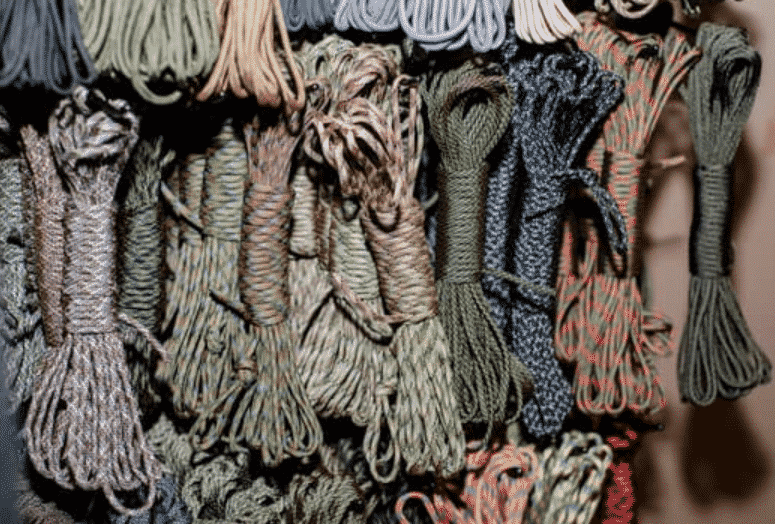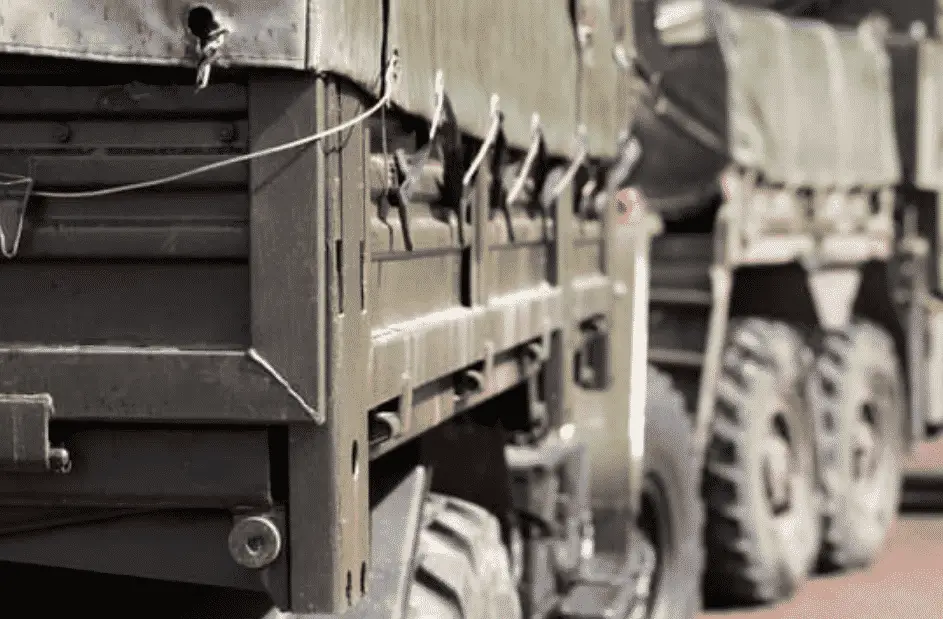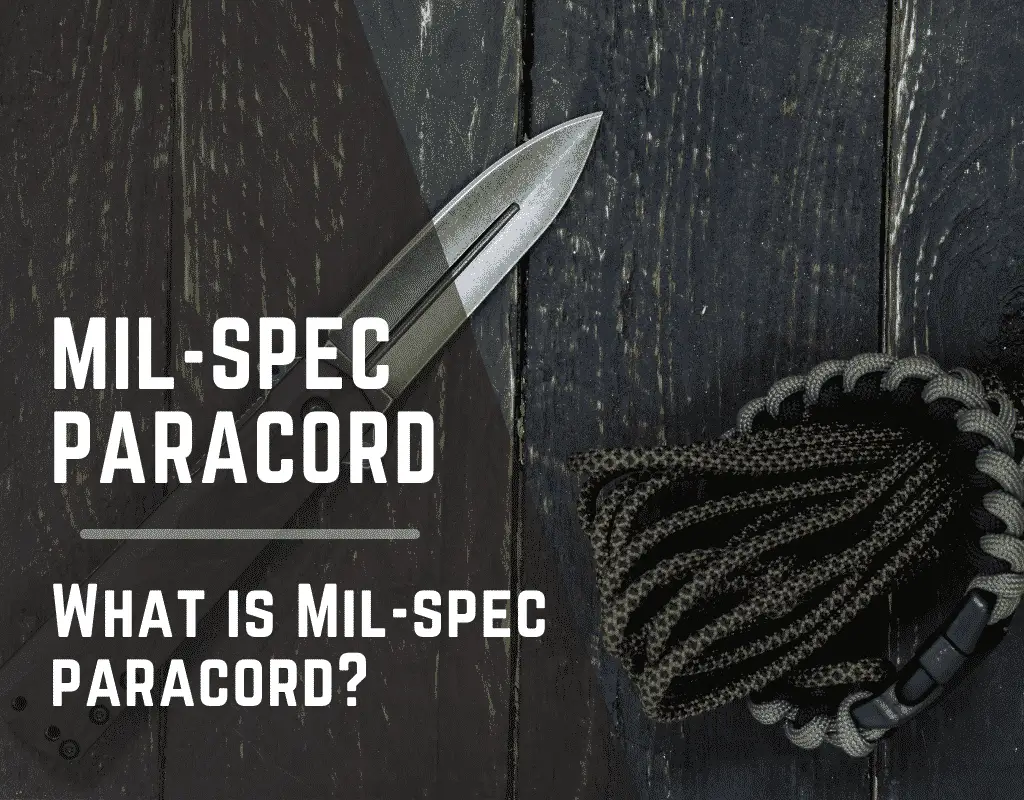Anybody that’s thought about buying paracord has ran into the term “Mil-Spec”. Is there really a difference between commercial and mil-spec grade paracord 550? Or is that just a marketing gimmick to increase the price? What is mil spec paracord?
Mil spec paracord is any type of paracord that passes military quality and testing standards. Real mil spec type 3 or 4 paracord 550/750 has a nylon outer shell (not polyester), army green or off-white color, and 7-9 twisted strands and a single tracer strand to designate cord strength. Some companies use the term “Mil Spec” to increase price so research the manufacturer before making a purchase.
Buying real Type 3 or Type 4 “Mil Spec” paracord guarantees a certain level of quality. There are 50+ rules that manufacturers have to follow to make real mil spec cord. The military runs the cord through extensive testing and makes sure it meets minimum quality standards.
Unfortunately, there’s no regulating body in the civilian market to inspect paracord so you have to research the manufacturer before making a purchase. I really like Paracord Planet’s 550 Mil-Spec Cord (I’ll let the color choices slide), but there’s lots of companies that sell comparable products.
In the rest of this post I’ll explain the difference between mil spec and commercial grade paracord. By the end of this post you might decide that Mil-Spec isn’t worth the increase in price!
What Does Mil Spec Paracord Mean?
The term Mil-Spec tends to get throw around by paracord manufacturers, but what does mil spec paracord actually mean? It doesn’t mean a whole heck of a lot since manufacturers tend to lie about the mil-spec rating. However, if you can find real mil-spec cord that gives a guarantee of extensive testing and the cord meets or exceeds advertised safety ratings.
So, what is mil-spec paracord? Mil-Spec paracord is paracord that passes milatary specifications as defined by document “Mil-C-5040”. It’s a 20 page document going over every single aspect of the paracord, giving set expections for the cord, and necessary testing protocols.
It goes over color, cleanness, thickness, knot strength, tensile strength, stretching, materials, yarn spacing, strand count, elongation, packaging, light/heat/water/chemical resistance, and at least 50 other random requirements. Ever single aspect of mil spec paracord needs to meet or exceed the minimum testing requirements to get certified.
The militaries been using paracord for over 100 years so they’ve really boiled down the testing criteria. Just look at the Static Line parachutes that were used in world war 2 that had 24 static paracord 550 lines to support a single persons body weight.
There are lots of different companies that sell “Mil-Spec” paracord. Unfortunately most of the sellers you see on Amazon and Ebay lie about their “Mil-Spec” rating. I really like Paracord Planet’s 550 Mil-Spec cord! It’s affordable, comes in 50-1000ft rolls, and it’s available in lots of different colors.
Technically mil-spec cord is only available in army green and off-white, but I’ll let that slide. You really can’t beat the quality and it’s about 2/3 of the price you’d pay at a typical outdoor gear store.
Difference between Mil-Spec and Commercial Grade Paracord

Don’t get so hung up on choosing between mil-spec and commercial paracord. There won’t be a noticeable quality difference between two similar cords from the same manufacturer. It’s better to focus on the technical specs of the product and look at the seller/product reviews.
Once you find a trusted manufacturer you can further boil it down to mil-spec vs commercial grade. Here are a few the ways to tell the difference between mil-spec and commercial cord.
- Strand Count: Real Mil-Spec cord has (7-9) strands in the center of the nylon shell and a manufacturer ID Tracer strand to designate the strength rating. Look at the picture above and notice the tracer strand in the paracord.
- Material: Nylon is the only approved material that can be used with mil-spec paracord. Some companies try to pass off polyester cords as mil-spec, but polyester is less durable. New polyester looks shinier than nylon and has distinct feel (think about polyester clothes).
- Color: Real mil-spec cord is only available in army green and off-white, but color doesn’t make any difference to the quality of the cord. Most companies sell a wide variety of “Mil-Spec” colors that technically aren’t approved, but you’d have to be a stickler to complain.
Going with commercial grade cord doesn’t alway mean that you’re buying a lower quality product. You just need to do your research on the manufacturer and watch out for signs of low quality products.
Quality paracord should have at least 7 strands of twisted 2 or 3 ply cord and not look frayed/fluffy. Reducing the amount of strands in the line puts extra strain on each individual cord. Spreading out the weight reduces the chance of catastrophic failure and increases the cord’s lifespan.
The outer shell should be made of nylon instead of polyester. Trust your gut, ask for a refund if it looks/feels cheap!
Is Polyester Paracord Really That Bad?
Paracord that’s made out of polyester isn’t always a bad thing. Polyester is more likely to tear under stress, but it does have some positive properties. Polyester won’t absorb water, it’s less likely to kink, and it’s heat/uv resistant.
If you’re using the paracord in a wet environment polyester is the way to go. Water decreases the strength of nylon paracord by 30% so a polyester cord will actually be stronger in wet environments. I use polyester covered all the time in my boat since I’m constantly soaking the lines.
Finding Real Mil-Spec Paracord
Finding real mil-spec paracord guarantees a minimum standard of testing, but there’s no regulatory body that tests paracord for the civilian market. So any company can claim that their product meets military specifications without ever undergoing military testing.
The only way to find out if it’s real mil spec paracord is to research the company and read reviews on the cord. Most of the cheap paracord manufacturers you see on Amazon and Ebay sell fake mil-spec cord. It’s probably good enough for most peoples needs, but it’s not worth paying the extra cost over budget cords.
Paracord Planet is one of the only companies that sell real mil-spec cord at a reasonable price. Here’s a listing of Paracord Planet’s Mil-Spec Paracord 550 Type 3 Cord. Some of the colors aren’t technically mil-spec certified, but they do pass all of the quality standards of military grad cord. You can buy their cords in a wide variety of colors and 50-1000ft spools at a reasonable price.
What Is The Difference Between Type 3 and Type 4 Mil-Spec Paracord

Mil-Spec paracord can be broken down into two distinct categories: type 3 and type 4 mil-spec cord. There are technically low strength Type I, IA, II, IIA cords that meet military specifications, but I’ve never seen those marketed as mil-spec cords.
- Type 3 Mil-Spec Cord (Paracord 550): Type 3 mill spec cord is similar to commercial grade paracord 550. That just means that it’s a 7-9 strand cord with a 550lb static load rating (aka tensile strength). It can hold 550lbs of un unmoving weight or 110-165lbs of realistic working weight.
- Type 4 Mil-Spec Cord (Paracord 750): Type 4 mil spec cord is similar to commercial grade paracord 750. It’s a 11 Strand cord with a 750lb static load rating and 150-225lb of realistic working weight. So it will be thicker and heavier than Type 3 cord.
I gave a brief explanation below, but check out my other post explaining paracord strength and weight limits for a deep dive into the topic
Most mil-spec paracord falls into the Type 3 Paracord 550 designation. Just understand that the above ratings are only for stationary and slow moving objects. As you apply falling force or dynamic force (directional energy) to the rope it will amplify the weight of the object. Work on the lower end of the recommend ranges and try to minimize object movement.
So you can’t use Paracord 550 for rock climbing, rappelling, or hanging a camping hammock even if your weight falls within the realistic working load range. All it would take is a quick 2-3 foot drop to increase the load past the ropes maximum approved rating.
Here’s an example: an average weight 180lb person could hang on paracord 550, but dropping 3ft would create 1806lbs of force causing catastrophic failure in the line. Longer drops would amplify the affect causing even more force (6ft drop is 3612lbs of force).
Do I Need Mil-Spec Paracord?
In all honesty, you probably don’t need mil spec paracord. Most people look at mil spec paracord as being superior to commercial grad paracord. In the back of your mind, it’s easy to justify a slight increase in cost to get a better product.
That’s true in some instances, but there’s no set standard for paracord that’s sold to the public. Real military paracord does guarantee an above average quality level and certified load ratings, since it goes through extensive testing.
Manufacturers have learned that labeling their cord as mil spec allows them to increase the price. So they label all their 550lb paracord as mil-spec type III and 750lb paracord as mil-spec type IV. They’re selling it in the civilian market, so there’s nobody to check the ratings and no penalty for lying about the rating.
There’s No Regulatory Body That Inspects Paracord
Unfortunately there’s no regulation of the term mil-spec so it can be hard to tell between two similarly branded paracord styles. Paracord isn’t like other products that have governement ratings (milk, eggs, etc.). The military inspects their purchases, but there’s no governing body to inspect the private sale of paracord.
A typical mil-spec 550 paracord line has 7 strands inside and paracord 750 has 11 strands. How well those strands hold up to stress will depend on the seller.
Paracord is only as reliable as the seller, so don’t go with cheap no-name Chinese paracord brands. The outer wrap will seperate from the inner cord and they use cheap inner strands that won’t stand up to abuse. Cheap paracords fine for basic tasks, but it’s not much more expensive for premium brands.
If you’re looking for a large roll of paracord go with a well regarded company like Paracord Planet (Paracord 550 Mil-Spec). All of their cords are certified mil spec at surprisingly low price compared to brands you’d find at outdoor stores. It’s about 2/3 of the price of what you can get at a typical outdoor store.
Just understand that if you buy a massive roll you’ll have to finish the ends to prevent splitting and fraying. Sealing the ends is easy! All you need to do is burn the end with a lighter to melt the paracord together. You may also want to touch up the end with a sharpie to make it look pretty.




